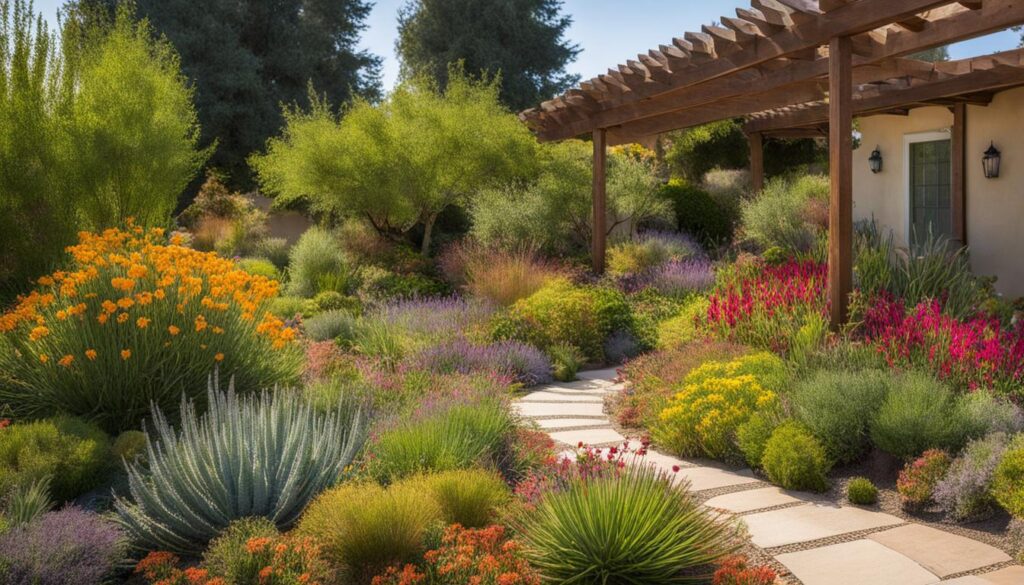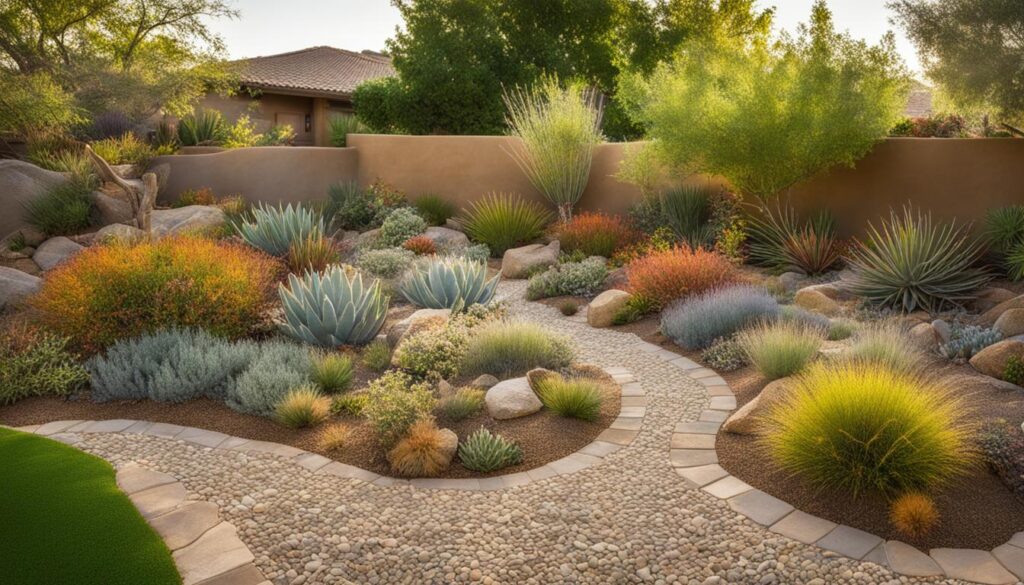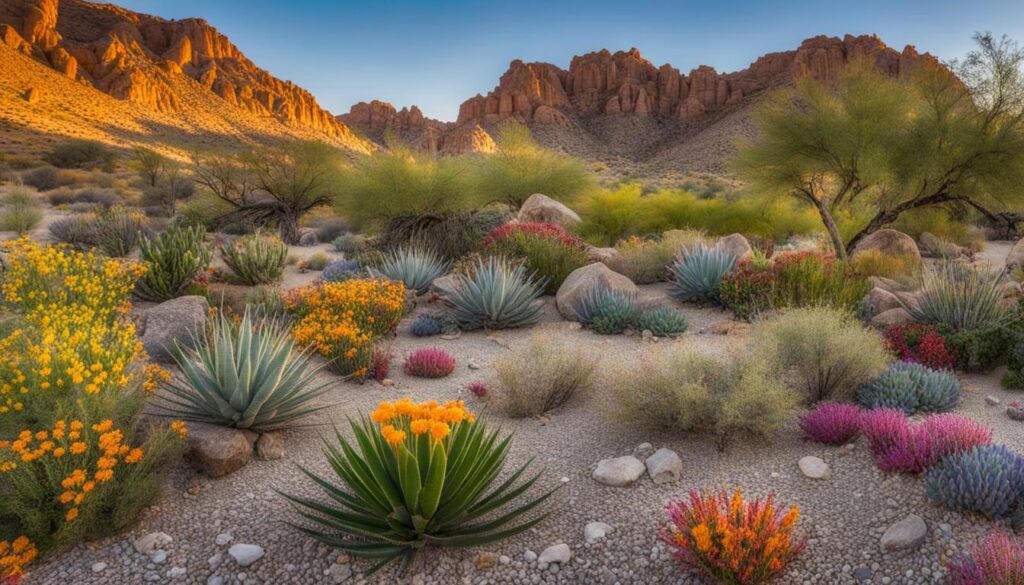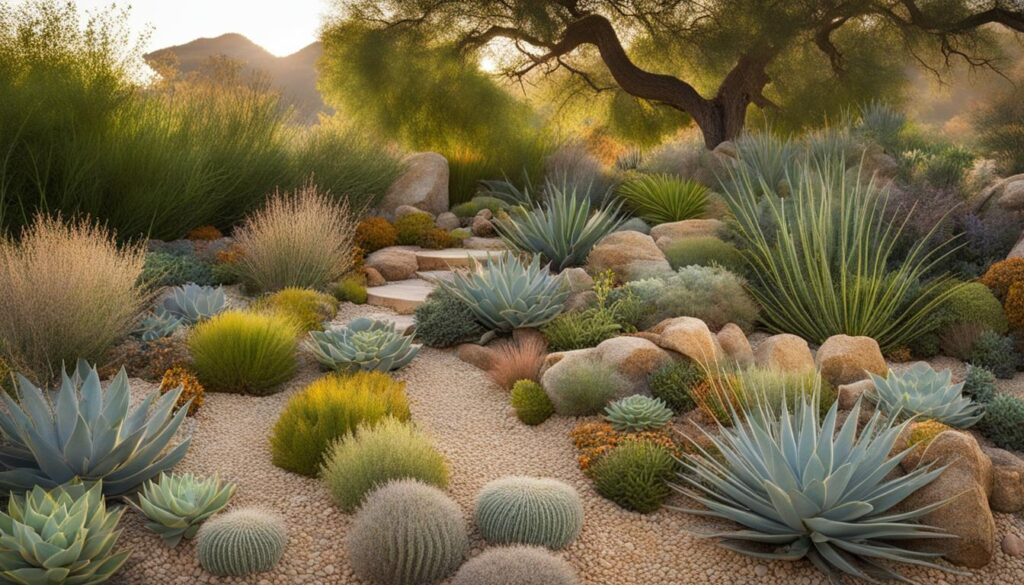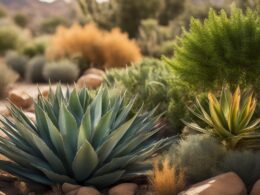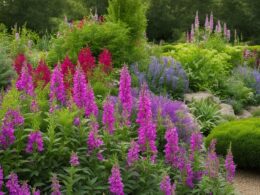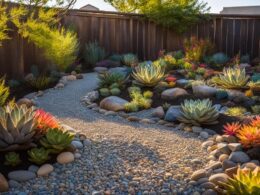Xeriscape landscaping is a low-water gardening technique that promotes water conservation. By incorporating native plants into your landscape, you can create a beautiful and sustainable garden that requires minimal irrigation. In this article, we will explore the best native plants for xeriscape landscaping in the United States.
Key Takeaways:
- Native plants are ideal for xeriscape landscaping as they are suited to the local climate and require less water.
- Xeriscape gardens can be both visually appealing and environmentally friendly.
- By planning in advance and using reliable resources, you can select the right native plants for your xeriscape garden.
- Xeriscape principles such as targeted irrigation and mulching can help conserve water.
- There is a wide variety of native plants available for xeriscape gardens, including succulents, flowering plants, trees, grasses, and shrubs.
Resources for Native Plant Selection
When it comes to selecting native plants for your xeriscape landscaping project, it’s essential to have reliable resources that can provide you with the information you need. Fortunately, there are several excellent sources available to help guide your choices and ensure a successful outcome.
California Friendly plants
One valuable resource is the Southern California garden guide provided by Metropolitan. This guide offers a comprehensive list of California Friendly plants that are well-suited for xeriscape landscaping. It provides detailed descriptions of each plant, including their water requirements, ideal growing conditions, and visual characteristics. By consulting this guide, you can easily identify the best plants to incorporate into your design.
Native plant database
Another valuable resource is the database offered by the California Native Plant Society. This database allows you to search for native plants based on specific criteria such as plant type, water needs, and sun exposure. It provides extensive information about each plant, including photos, growing tips, and ecological benefits. With this database, you can discover a wide range of native plants that will thrive in your xeriscape garden.
Landscaping information
Additionally, websites like Calscape.org, the California Department of Fish & Wildlife, and PlantRight offer a wealth of information on landscaping with native plants. These websites provide planting guides, design tips, and resources for creating and maintaining a successful xeriscape garden. By utilizing these resources, you can make informed decisions and ensure that your native plant selection aligns with your landscaping goals.
With these resources at your fingertips, you can confidently choose the right native plants for your xeriscape landscaping project. Whether you’re a beginner or an experienced gardener, these tools will provide the information and inspiration you need to create a sustainable and beautiful garden that conserves water and supports local ecosystems.
Design Templates for Xeriscape Gardens
Xeriscape gardening can be made easier with the help of design templates specifically tailored for native plant landscapes. Bloom! California offers a range of design templates that cater to various garden needs and preferences. These templates provide inspiration and guidance for incorporating drought-adapted plants into your xeriscape garden, ensuring a sustainable and water-efficient landscape.
Shady Refuges
If you have areas in your garden that receive limited sunlight, the shady refuge template is perfect for you. It features native plants that thrive in shady conditions, adding greenery and beauty to those often overlooked parts of your garden.
Sunny Pollinator Patches
Creating a pollinator-friendly garden is not only beneficial for the environment but also adds vibrant colors and life to your landscape. The sunny pollinator patch template includes a selection of native plants that attract bees, butterflies, and other pollinators, ensuring a thriving ecosystem in your xeriscape garden.
Privacy Hedgerows
If you value privacy in your outdoor space, the privacy hedgerow template is ideal. It features native plants that grow into dense hedges, providing both privacy and beauty. These plants require minimal irrigation, making them perfect for a xeriscape garden.
Planning Your Xeriscape Garden
Before you begin planting your xeriscape garden, it’s important to take into account the specific characteristics of your garden. By considering factors such as light conditions, wet spots, and plant zones, you can make informed decisions about the types of native plants that will thrive in your landscape.
Start by assessing the light conditions throughout your garden. Observe how much sun each area receives during different times of the day. This will help you determine which areas are suitable for sun-loving plants and which areas are better suited for shade-tolerant varieties.
Additionally, identify any wet spots in your garden where water might accumulate. These areas may require plants that can tolerate higher moisture levels to prevent waterlogged roots. By considering these wet spots, you can strategically choose plant species that are well-suited to these conditions.
To further optimize your plant selection, divide your garden into smaller zones based on similar conditions. This allows you to easily identify areas with similar light levels, moisture levels, and soil conditions. By grouping plants with similar needs together, you can create microclimates within your garden that foster healthier growth and minimize the amount of water you need to use.
Key considerations for planning your xeriscape garden:
- Assess the light conditions in your garden and determine suitable plant choices for areas with different levels of sun exposure.
- Identify any wet spots where water might accumulate and select plants that can tolerate higher moisture levels.
- Divide your garden into smaller zones based on similar conditions to create microclimates that promote plant health and reduce water usage.
By taking the time to plan your xeriscape garden and considering its unique characteristics, you can ensure that your plants thrive while conserving water.
Xeriscape Principles for Water Conservation
Xeriscaping, a water-conserving landscaping technique, aims to create sustainable gardens that minimize water usage. By following specific principles, you can design a xeriscape garden that reduces water waste and promotes plant health. The key principles for water conservation in xeriscaping include:
1. Planning Everything in Advance
Prioritize proper planning to ensure your xeriscape garden is efficient and effective. Consider factors such as soil type, sun exposure, and the specific water needs of different plant species. By designing your garden with these factors in mind, you can optimize water usage and promote overall sustainability.
2. Limiting Turfgrass to a Minimum
Turfgrass requires significant water and maintenance to thrive, making it less suitable for a water-conserving garden. Instead of extensive lawns, consider using other ground covers or hardscaping elements such as gravel or mulch. This reduces water consumption and minimizes the resources required to maintain your garden.
3. Choosing Plants with Lower Water Needs
Selecting native plants and drought-tolerant species is crucial for a water-conserving garden. Look for plants that have adapted to your region’s climate and require less irrigation. These plants are more likely to thrive in your xeriscape garden with minimal water usage, reducing the need for constant watering.
4. Grouping Plants with Similar Watering Needs Together
Efficient irrigation can be achieved by grouping plants with similar watering requirements together. This allows you to target water resources more effectively and avoid overwatering or underwatering certain areas of your garden. By creating irrigation zones, you can tailor watering schedules and methods to suit each group of plants, promoting water conservation.
5. Using a Targeted Irrigation System to Reduce Water Waste
Investing in a targeted irrigation system, such as drip irrigation or soaker hoses, can significantly reduce water waste in your xeriscape garden. These systems deliver water directly to the plant’s root zone, minimizing evaporation and runoff. By delivering water precisely where it’s needed, you can maximize the efficiency of your irrigation and conserve water.
6. Mulching Around Plants to Reduce Water Evaporation
Mulching is an effective technique to reduce water evaporation from the soil surface. Apply a layer of organic mulch around your plants to retain moisture, suppress weeds, and regulate soil temperature. This allows plants to access water for a longer period, reducing the frequency of watering and promoting overall water conservation.
7. Maintaining or Pruning Plants to Prevent Heavier Water Needs
Regular maintenance and pruning of your xeriscape garden are essential to prevent excessive water needs. Removing dead or damaged plant material and keeping plants properly pruned can help conserve water by optimizing their overall health and reducing the resources required for their growth. Additionally, pruning can improve air circulation, reducing the risk of diseases that may require additional watering.
Types of Xeriscape Plants
Xeriscape gardens offer a wide range of plant options that can thrive in low-water conditions while adding beauty and visual interest to your landscape. From succulents to flowering plants, trees, grasses, and shrubs, there are numerous choices available to create a lush and sustainable xeriscape garden.
“Sedum rubrotinctum, Pachysandra procumbens, Dwarf lilyturf, Black mondo grass, Lace aloe, Santa Barbara daisy, Myrtle spurge, Russian stonecrop, Shore juniper, and Purple poppy-mallow are some popular options for xeriscape gardens.”
Succulents are an excellent choice for xeriscaping due to their ability to store water in their leaves and stems. They come in various shapes and sizes and can add a unique and striking element to your garden. Some common succulents for xeriscape gardens include Hens and Chicks (Sempervivum), Agave, and Echeveria.
Xeriscape Trees
- Red Yucca (Hesperaloe parviflora): A drought-tolerant tree that produces tall flower spikes and adds a touch of architectural interest to your xeriscape garden.
- Desert Willow (Chilopsis linearis): This tree features beautiful trumpet-shaped flowers and provides natural shade for your garden.
- Olive Tree (Olea europaea): With its evergreen foliage and low water requirements, the olive tree is a popular choice for xeriscape gardens. It also produces olives, adding an edible element to your landscape.
Grasses are another great addition to xeriscape gardens, as they are low-maintenance and require minimal water. Ornamental grasses like Mexican Feather Grass (Nassella tenuissima) and Blue Fescue (Festuca glauca) can add texture and movement to your landscape.
Shrubs are essential in providing structure and filling out the garden. Some drought-tolerant shrubs for xeriscape gardens include Dwarf Coyote Brush (Baccharis pilularis), California Lilac (Ceanothus spp.), and Manzanita (Arctostaphylos spp.). These shrubs offer a variety of colors and textures, adding depth and visual interest to your garden.
With a well-planned selection of succulents, flowering plants, trees, grasses, and shrubs, your xeriscape garden can be a vibrant and sustainable oasis that thrives with minimal water. Consider the specific needs of each plant and create a harmonious composition that showcases the beauty and resilience of xeriscape gardening.
:What are the Best Native Plants for Xeriscape Gardens Specifically for Flowering?
When creating a xeriscape garden with a focus on flowering, it’s essential to choose native flowering plants xeriscape gardens. Some top choices include the purple coneflower, black-eyed Susan, and the blanket flower. These vibrant options bring beauty to your garden while requiring minimal water and maintenance.
Conclusion
Xeriscape gardening with native plants is a sustainable and eco-friendly way to enhance the beauty of your garden while conserving water. By incorporating resilient and reliable native plants into your xeriscape landscape, you can create a lush and vibrant garden that requires minimal irrigation.
Using the principles of xeriscaping, you can design a water-conserving landscape that not only reduces your water usage but also supports the local ecosystem. By grouping plants with similar watering needs together, using a targeted irrigation system, and mulching around plants to reduce water evaporation, you can create a self-sustaining environment that thrives with minimal intervention.
Choose native plants that are well-suited to your garden’s characteristics, such as light conditions and wet spots. By selecting plants that are adapted to your specific region, you can ensure their success and reduce the need for excessive watering and maintenance.
With careful planning and thoughtful plant choices, you can enjoy a thriving xeriscape garden that benefits both the environment and your outdoor space. Embrace the beauty of native plants and join the movement to conserve water through xeriscape gardening.






